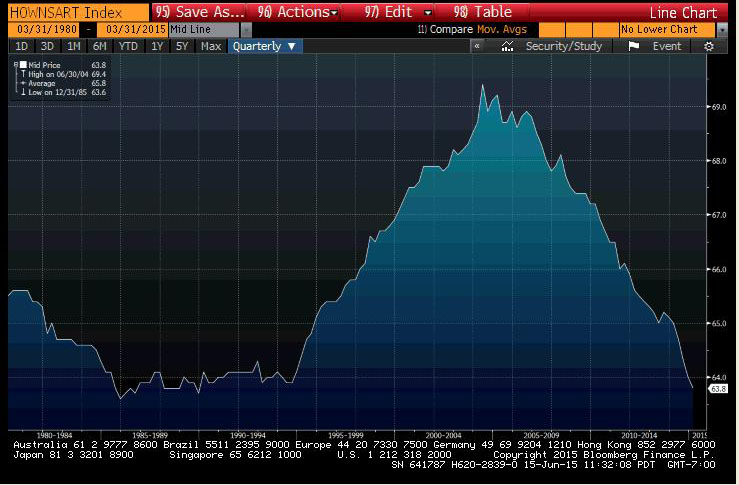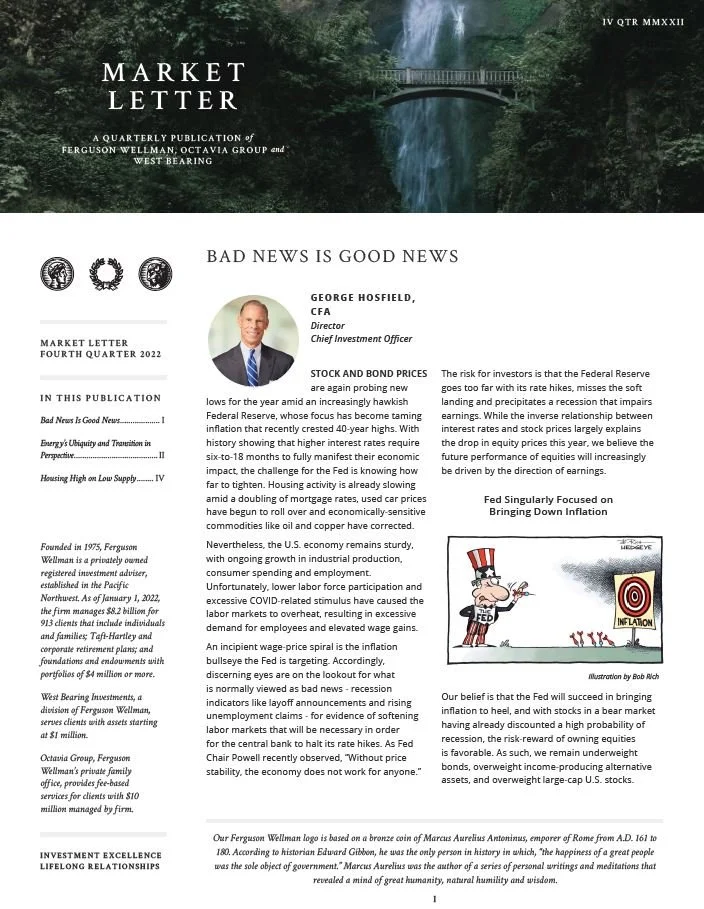Recently, a realtor friend of mine shared that transaction volume was notably low due to high interest rates, resulting in a sluggish market. However, with last week’s Federal Reserve’s rates cut, he and likely others in the realty industry are hoping the housing market will be reenergized. While not everyone can buy or sell a house, home ownership is a prominent consideration when creating wealth. And while I’m not in the market to sell my house, I was curious about what is now occurring in the housing market.
A Different Type of Housing Crisis
In recent months, we have received a number of questions from clients regarding the possibility of another housing crisis. While we do not see a housing crash like the one experienced in 2008, there is a different type of disruption in the residential real estate market.
Hop, Skip and a Jump?
At Ferguson Wellman, we are nearing the end of our Mid-Year Update events season, where we present updates to our yearly Investment Outlook and deepen our connections with clients and the community.
Fourth Quarter 2022 Investment Strategy Video: Bad News Is Good News
George Hosfield, CFA, shares our fourth quarter 2022 Investment Strategy video, in which he discusses the Fed raising interest rates in an effort to combat inflation and what that means for investors.
Fourth Quarter 2022 Market Letter: Bad News Is Good News
Read our Market Letter publication for the fourth quarter 2022 titled, Bad News Is Good News, in which George Hosfield, CFA, Peter Jones, CFA, and Joe Herrle, CFA, share our thoughts on inflation, interest rates, the energy sector and housing supply in the United States.
Market Turbulence: Remain Focused on Long-Term Fundamentals
Some while ago as I was preparing for my first solo overseas flight, I told a friend in the aviation industry that I disliked turbulence; the stomach-churning drops and swings were too sudden and unpredictable for my appetite.
Cross Currents
A mixed set of economic data set against ongoing news of coronavirus infections sent stocks and bonds in opposite directions. As quarantines and lost production in China begin to impact supply chains and the likes of Apple, bonds continued their long tenured ascent, helping offset the week’s equity losses for those investors with a well-diversified portfolio.
Multifamily Living Multiplies
 by Brad Houle, CFA
Executive Vice President
by Brad Houle, CFA
Executive Vice President
Demand for commercial real estate from investors has been robust for the past few years. In a world of low interest rates, the relative yield advantage of owning commercial real estate is attractive to investors. In addition, trophy commercial properties in gateway cities like New York and San Francisco are seen as a “store-of-value” to foreign investors. When international investors are faced with a volatile home currency or an unstable government, the thought of owning a landmark building in an American city is a relatively prudent investment. As a result, real estate transactions in coastal cities have occurred at price levels that imply a very meager return for the buyer.
While most categories of commercial real estate have performed well, one of the most robust has been apartment buildings. Home prices have rebounded sharply since the Great Recession, particularly in the “cool” cities that millennials prefer to call home. One would think that the millennial generation is the demographic driving new household formation and should be in their prime first-time home buying years. However, a cultural shift has taken place whereby millennials are waiting longer to get married, start families and often prefer to rent for a number of reasons.
According to the U.S. Census Bureau, home ownership as a percentage of households has declined nationally from nearly 70 percent in 2004 and 2005 to 63.8 percent in 2015. A one-percentage-point change in home ownership rates equates to 1.3 million households, according to Bloomberg data. Lending requirements for first-time home building have been tightened dramatically since the financial crisis and the 20-percent down payment requirement disqualifies many millennial prospective homebuyers.
Home Ownership as a Percentage of Total Households

According to Bloomberg, apartment construction nationally has been rising since 2009. Apartment construction permits, a leading indicator of multifamily construction, was at an all-time high of 557,000 units in May. Permits last approached this level in June 2008.
Broadly speaking, real estate development moves in cycles. Whether it’s the unsold condos following the 2009 financial crisis or the now ubiquitous “selfie stick,” we have seen firsthand that whatever the hot trend happens to be is, it has the potential to … cool down.
Greekspeak
This week there continued to be directionless news flow regarding the continued debt crisis in Greece. While it is impossible to determine what the outcome may be, one thing is certain: The market has a high level of Greece fatigue. Investors are weary of the issue and it appears that even the correspondents on CNBC are tired of reporting on it. We are closely monitoring the debt of neighboring southern European nations for any sign of contagion and thus far, the crisis does not seem to be spreading. July 20 is now viewed as a critical day, according to Bloomberg, as Greece owes the European Central Bank (ECB) 3.5 billion euros on that day. If there is a failure to pay, this would put Greece on the way to getting the boot by the EU. Interestingly, Greece will possibly delay payment to the International Monetary Fund (IMF) this month with no real consequences as liquidity will not be cut off to Greek banks. Evidently, not paying back the IMF is something akin to not paying back your in-laws with the only consequence being an awkward Thanksgiving dinner. The impact of not paying back the ECB is similar to not paying back the guy you borrowed money from at the racetrack.
In addition, the Federal Open Market Committee minutes were released this week. Parsing every word of the Fed minutes revealed that interest rates may rise in September and December of this year. This quote possibly has been the most over-analyzed and highly anticipated Fed rate hike of all time. Ultimately, this is good news: The Fed thinks the economy is robust enough that they need to tap the brakes to keep it from getting overheated.
Our Takeaways for the Week
- Expect interest rates to make small movements upward in the fall
- The multifamily housing market is robust and is likely to peak this year
Moving Out
 by Brad Houle, CFA
Executive Vice President
by Brad Houle, CFA
Executive Vice President
In the month of March, sales of previously owned homes increased to 6.1 percent. Sales of 5.19 million homes is the highest level we’ve seen since 2013. At the height of the housing bubble prior to the great recession in 2008, existing home sales were as high as 7 million a month in the summer of 2005.
Following the 2008 crisis, existing home sales dropped as low as 3.5 million in June of 2010. While we will probably not see a return to 7 million homes sale in a month, the housing market is most certainly recovering. New home sales have followed a similar pattern, peaking prior to the crisis at 1.25 million in the summer of 2005 and now are averaging around 500,000 new homes per month.
Home sales are driven by new household formation as well as job growth. New household formation is defined as individuals who are between the ages of 25 and 35 moving out of their parents’ basements to live on their own. While many people in the millennial generation prefer to rent, some are becoming first-time home buyers which is driving entry-level housing sales. Payroll growth has been robust with the unemployment rate dropping from 10 percent post-financial crisis to only 5.5 percent. There is a strong correlation with home sales and payroll growth as people become more secure in their employment … home sales follow.
Housing supply is low relative to historical rates with less than 5 months of supply. During the downturn, inventory ballooned to more than 12 months of supply. A lack of supply is driving prices higher in many markets also fueled by low interest rates.
Anecdotally there are tales of home buyer bidding wars in tight markets and other frenzied 2006 housing bubble behavior. According to the S&P/Case Shiller Home Price Index, home prices in the U.S. have only recovered 54 percent of the value lost since 2006. The most important difference between housing activity now and prior to the downturn is that lending requirements are much more stringent than in the past. Gone are the days of stated income loans, also known as liar loans, and no-money-down subprime lending. Lending requirements now require actual income and asset verification as well as a 20 percent down payment.
Our Takeaway for the Week
o Despite positive housing news, we do not think this industry is heading into bubble territory













